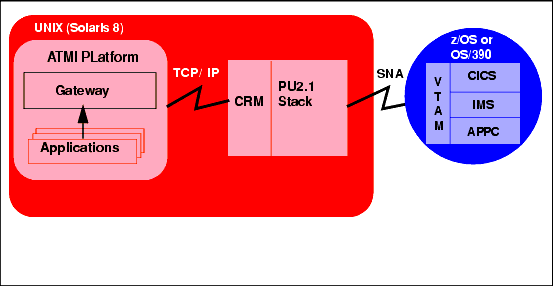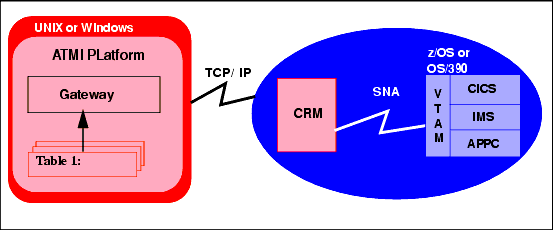


|

|
|
|
|
Preparing to Install eLink Adapter for Mainframe
This section contains information to help you prepare to install BEA eLink Adapter for Mainframe software. To ensure successful installation and operation of the eLink Adapter for Mainframe software, complete the tasks described in this section.
This section contains the following topics:
Note: All references to ATMI files, functions, and documentation apply to Tuxedo files, functions, and documentation.
Determining Your Configuration
You must consider configuration as you prepare to install the eLink Adapter for Mainframe software. The normal eLink Adapter for Mainframe environment includes two properly configured components: the eLink Adapter for Mainframe Gateway and the Communications Resource Manager (CRM). The type of network connectivity you are working with determines which type of CRM installation and configuration is required.
When the eLink Adapter for Mainframe Gateway and CRM are installed on the same machine, the installation is referred to as a local (combined) configuration. When these components are installed on different UNIX, Windows, or mainframe platforms, the installation is referred to as a distributed (or remote) configuration. The diagrams in the following sections show examples of the eLink Adapter for Mainframe components in three types of configurations.
Local Configuration
Local configuration installs the application, the eLink Adapter for Mainframe Gateway, the Application-to-Transaction Monitor Interface (ATMI) platform, and the CRM with the stack on the same UNIX platform. In this case, the UNIX platform is Solaris 8 because this is the only non-mainframe UNIX platform that the CRM supports. This configuration uses the IBM proprietary SNA protocol for transactions with the mainframe via the stack. This configuration requires a one-to-one relationship between the local eLink Adapter for Mainframe Gateway and the CRM.
Figure 1-1 Local Configuration
Distributed Configurations In a distributed configuration, the CRM is installed on a different platform than the eLink Adapter for Mainframe Gateway and applications. One type of distributed configuration separates applications and the eLink Adapter for Mainframe Gateway from the CRM by installing the CRM to the z/OS or OS/390 mainframe. This configuration eliminates the need for a third-party stack on the UNIX machine. This configuration requires a one-to-one relationship between the local eLink Adapter for Mainframe Gateway and the remote CRM. Figure 1-2 Distributed Configuration
Another type of distributed configuration separates applications and the eLink Adapter for Mainframe Gateway from the CRM on different UNIX or Windows-based platforms. In this case, the platform for the CRM would be Solaris 8 because Solaris 8 is the only non-mainframe UNIX platform that the CRM supports. This configuration uses Transmission Control Protocol/Internet Protocol (TCP/IP) connectivity between the eLink Adapter for Mainframe Gateway and the CRM, as well as the SNA connectivity to the mainframe environment(s). This configuration provides the flexibility to deploy the ATMI platform separately from the CRM in installations that require the ATMI platform on an operating system other than the one on which the SNA stack is running. This configuration also requires a one-to-one relationship between the local eLink Adapter for Mainframe Gateway and the remote CRM. Figure 1-3 Alternate Distributed Configuration

Determining Requirements for Other Components
Whether your eLink Adapter for Mainframe software is installed on Windows, UNIX, or a mainframe, make sure your system meets the appropriate requirements and that supporting software is operating correctly. The following sections describe mainframe and non-mainframe requirements, and verification of supporting software installations.
Note: Because eLink Adapter for Mainframe interacts with mainframe applications, involve your mainframe system support personnel early in the process of planning and installing your eLink Adapter for Mainframe software. Different individuals may be responsible for Multiple Virtual System (MVS), Virtual Telecommunications Access Method (VTAM), Information Management System (IMS), and Customer Information Control System/Enterprise Systems Architecture (CICS/ESA). Make sure everyone is involved.
Mainframe Requirements
Whether the CRM component of eLink Adapter for Mainframe is located on the mainframe environment or not, mainframe configurations affect how eLink Adapter for Mainframe software functions. Prepare the mainframe to conduct operations within the eLink Adapter for Mainframe/ATMI platform environment by:
Refer to the BEA eLink Adapter for Mainframe CRM Administration Guide for detailed information about these tasks.
Non-Mainframe Requirements
A non-mainframe environment is a UNIX or Windows machine running the eLink Adapter for Mainframe software. The software is fully bidirectional, supporting the local system as either a client or server. This environment consists of the following components:
Note: The Tuxedo ATMI platform is not required if you are installing the CRM only on Solaris 8.
Installing the Prerequisite Software
The following software should be installed and configured prior to installing the eLink Adapter for Mainframe software for UNIX or Windows:
Refer to the eLink Adapter for Mainframe Release Notes for a list of supported SNA stacks.
Note: Refer to the SNA stack vendor's documentation on configuring your environment. A properly configured SNA protocol stack is required for the CRM to communicate with the mainframe application.
Refer to the corresponding product installation documentation for installation and configuration information. Some specific configuration tasks must be completed before you install eLink Adapter for Mainframe.
Do not run the following commands until the installation is complete:
Upon completion of these tasks, continue to Installing the eLink Adapter for Mainframe for instructions on installing the eLink Adapter for Mainframe software.

|

|

|
|
|
|
Copyright © 2001 BEA Systems, Inc. All rights reserved.
|